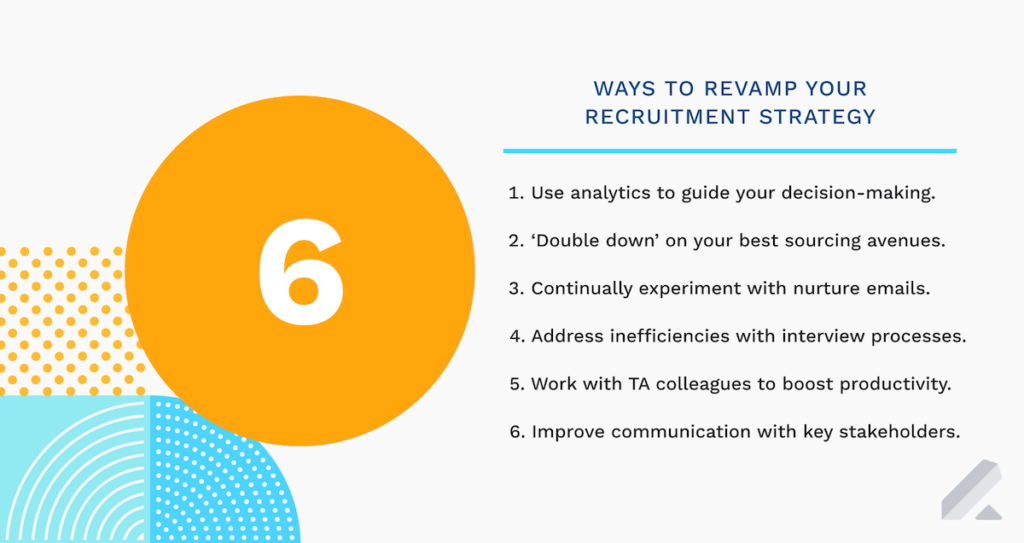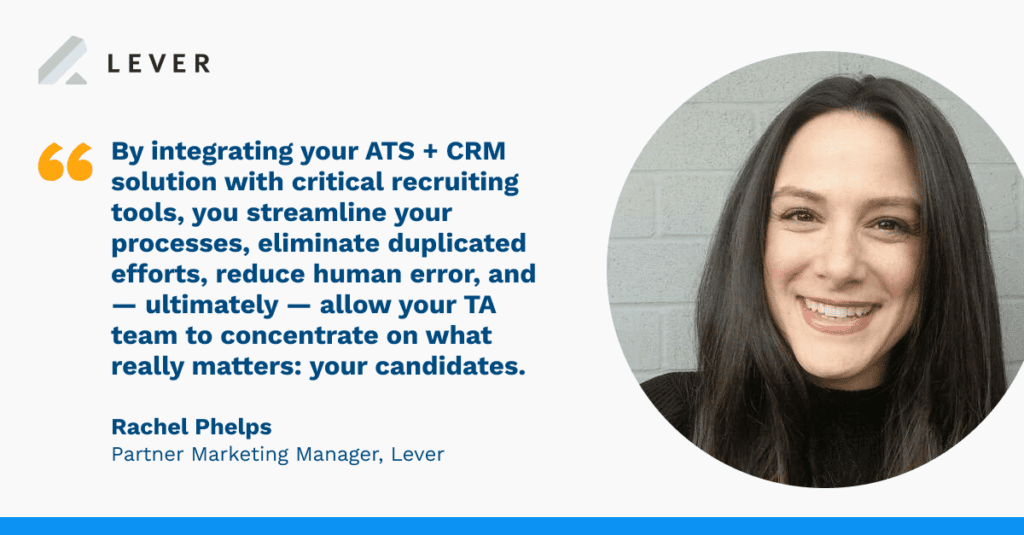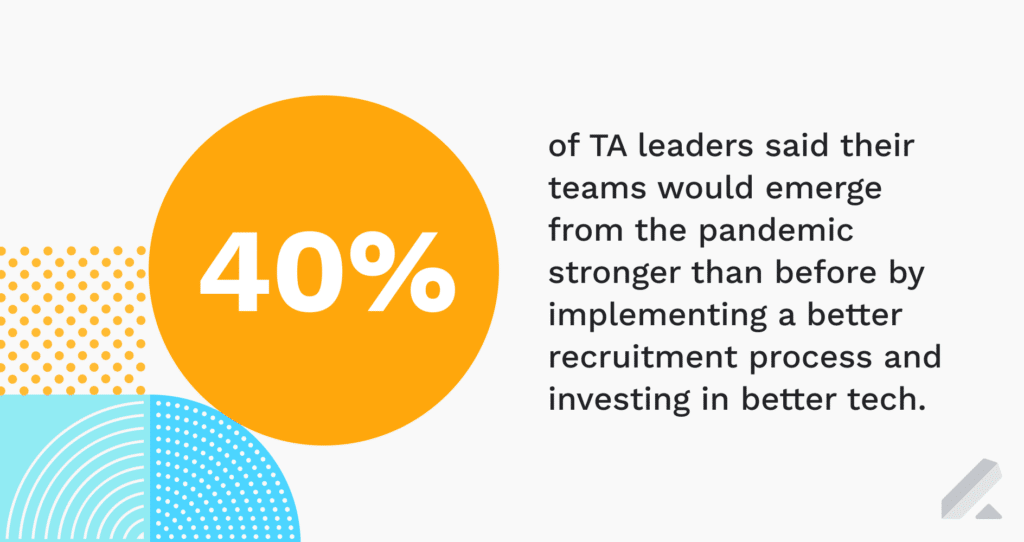You and your team work hard to develop your recruitment strategy. That means it’s only right to analyze and optimize your approach often. (Perhaps even daily.)
But knowing how to elevate your recruiting efforts (i.e., identify, engage, interview, and hire qualified candidates with great speed and efficiency) is equally important.
This is especially true today — a time in which top talent is scarce and employers are competing for and reaching out to many of the same individuals who have a strong mix of skills and experience they desire for teams with open roles.
That only 37% of talent orgs spent time rethinking their recruiting processes and tracking their recruitment goals amid this ongoing period of disruption and change shows there’s a big opportunity for your team:
To be forward-thinking with your recruitment strategy
You may ask, “How can we avoid this kind of inertia and future-proof our recruiting efforts?”
The answer: Be more proactive with your talent acquisition approach — and implement advanced TA tech and processes around leveraging your ATS and recruiting tools.

How to implement a more effective recruitment strategy — and improve hiring processes — in 2024
Here are some ways you can level-up your recruitment strategy in 2024 (and beyond).
Use your talent analytics to guide all of your recruiting and hiring decision-making
How many individuals in your talent pool are currently being nurtured and interviewed. Which job boards and social media platforms lead to the most applicants for open roles. How much time job seekers spend in each stage of your respective recruiting funnel.
There is a lot of talent acquisition data you can track and take action on to improve your recruitment strategy in the short and long term.
Once you know exactly which data points can help you move the needle the most in terms of improving your recruitment strategy — and have an advanced talent analytics platform in place — you can use said data to inform your daily sourcing, nurturing and interviewing.
As Randstad Board Member Rebecca Henderson recently wrote for Forbes:
“[C]ompanies are looking for ways to convert ever-increasing amounts of data into valuable insights, particularly with regards to how they acquire and utilize talent and promote diversity and inclusion within their organizations.”
A rich, real-time view of active and passive candidates (e.g., who engages with nurtures, candidate demographics via EEO/DEI surveys) and your core recruiting activities and tasks (e.g., which interview panelists owe you feedback, what requisitions are open and upcoming) can help you take your recruitment strategy (and DEI initiative) to new heights.
The key to analytics success, though, is to take action on data in a timely manner.

Assess where you successfully recruit prospects and double down on those sources
One data subset to track closely is which sources are “strong” and “weak.”
No recruiter wants to waste their time on job boards and career communities that yield mostly low-quality candidates. (That is, people who are not well-suited for the roles they end up getting hired for or simply a bad company culture fit).
Thus, it only makes sense to use the aforementioned analytics to understand where it’s worth allocating your person hours, resources, and advertising spend to find candidates who ‘fit the bill’ for active roles and which ones to stop using altogether.
In addition to pinpointing your premier and poor-performing external sources, don’t forget to tap into an existing recruiting resource that can ease your team’s workload: your workforce.
Employee referral programs can incentivize staff members to handle some of your sourcing work for you (i.e., tapping into their networks). What’s more, there’s the internal mobility angle: discovering which employees want to (or should) move up within your org.
(Reminder: While you analyze the efficacy of sourcing avenues, don’t forget to routinely update your careers page so it’s easy for current employees and prospects to find and navigate.)

Continually test variants of your nurture messaging until you find the right ‘formula’
Testing different nurture messaging is something demand generation and email marketing managers are accustomed to. Talent acquisition professionals? In many cases, not so much.
That’s historically been the case, though, simply because talent specialists have lacked tech that helped them both connect with and customize copy for candidates in a single location (i.e., as opposed to using two or more disparate communications tools) easily and quickly as well as experiment with that nurture messaging in an intelligent manner.
That’s why many TA orgs are turning to LeverTRM: our complete ATS + CRM.
Our advanced and intuitive talent-nurture capabilities make it easy to modify email messaging to both individual candidates and groups of candidates you’ve sourced.
Trying different email schedules, cadences (i.e., number of campaign ‘touchpoints’), and messaging (e.g., copy length and tone; job-description details included) to high-quality, passive candidates in your pipeline you think would be optimal fits for specific roles and constantly evaluating their performance is how you can gradually improve each of your nurtures.
Consistent nurture experimentation leads to optimization. Optimization leads to more engagement. More engagement leads to more, high-quality hires. It’s that simple.

Fix operational issues with interview processes to save time and boost productivity
Every talent team ‘pivots’ from time to time — including the Lever recruiting organization.
Whether it’s embracing virtual screening and interviewing or overhauling the language used in job descriptions to make it more inclusive, there are many ways talent acquisition teams can (and should) pivot to improve the output of their recruiting and hiring.
Whenever making adjustments, though, consider the impact those changes — particularly those for the interview process — will have on the team’s operational efficiency.
Sure, measuring productivity as it pertains to standard talent metrics (e.g., pipeline growth, diverse hires, CX scores, employee retention) is vital.
But, you also need to focus on operational metrics, like how long it takes prospects to move through your interview stages and what internal “barriers” may exist that deter quick and efficient candidate interview processes.
Sometimes, these issues that prevent speedy interview cycles lie outside the talent team. For example, hiring managers may fail to provide timely feedback to recruiters on job seekers.
Whatever the problem(s), you need to audit your structured interviewing efforts at the individual recruiter level and macro team level to identify and address any ‘chokepoints.’

Improve collaboration and communication with all recruitment strategy stakeholders
Communication is a two-way street. That said, you shouldn’t wait on HR, hiring managers, or execs to connect with you on critical business matters that affect your recruiting and hiring.
Rather, you must proactively seek them out to ensure your TA team is set up for success.
If your C-suite decides to enhance the benefits and perks offered to employees to boost retention and better attract potential candidates, that’s info your team needs to know.
Why? Because they’ll want to mention those “rewards” in job descriptions for each posting and targeted nurtures, while HR incorporates them in their employer branding efforts.
Conversely, your HR director and executive team will want to be kept abreast on the latest recruiting and hiring data across the talent team.
That means it’s critical to share custom dashboards featuring only the insights of interest to said business and hiring stakeholders.
(Side note: Creating and sharing dashboards is something you can do with ease in LeverTRM. You can even schedule dashboards to be sent to colleagues on the cadence of your choice).
Learn how LeverTRM can enhance your recruitment strategy and daily TA activities: from scheduling video interviews and publishing job postings to engaging top candidates.



